Photo
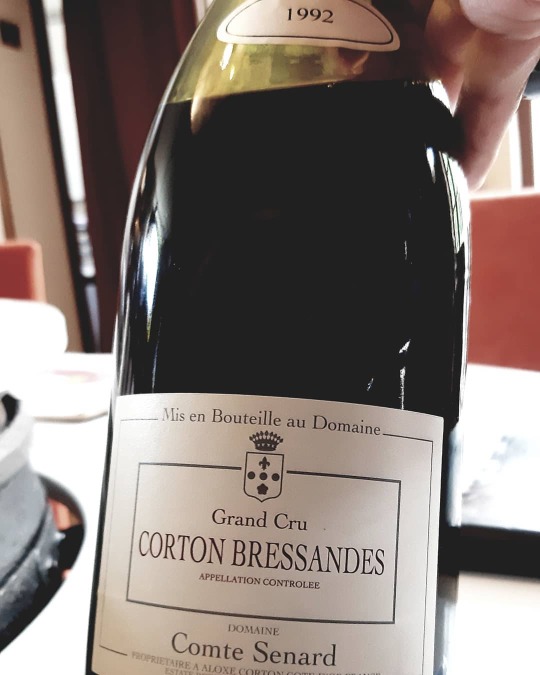
Ever wondered what a bottle of wine at its peak tasted like? I was lucky enough to come across this gem on the job while out with clients when @baptistemyr21 poured this blind on us which left us in complete awe. Made me reflect on ageing potential and especially not just shrug off something that might not seem like to be in its best shape but instead let patience, time do their magic❤ . Merci @emilie.jolivet.31 @domainecomtesenard . @christinarasmussen_ @andrehaglund #premiercru #grandcru #burgundywine #burgundylovers #burgundy #frenchwine #vinsdebourgogne #vinsfrancais #bourgognetourisme #bourgognefranchecomté #domaineponsot #chardonnay #pinotnoir #gamay #aligote #winelover #wineporn #foodporn #winepictures #wineportraits #wsetstudent #wsetglobal #masterofwine #oldvintage #oldwine #sommelierlife #cortongrandcru (at Comte Senard) https://www.instagram.com/p/CDJDzYQJvrw/?igshid=61vlqwmeljfw
#premiercru#grandcru#burgundywine#burgundylovers#burgundy#frenchwine#vinsdebourgogne#vinsfrancais#bourgognetourisme#bourgognefranchecomté#domaineponsot#chardonnay#pinotnoir#gamay#aligote#winelover#wineporn#foodporn#winepictures#wineportraits#wsetstudent#wsetglobal#masterofwine#oldvintage#oldwine#sommelierlife#cortongrandcru
0 notes
Photo

🇦🇹I have long been a massive fan of Austrian wines for a few reasons: Coming out of the shadow and sticking to its guns within a very short timeframe (first established DAC came in 2006) and moving towards the future with higher and higher quality wines of its own (few international varieties planted where local varieties thrive) [...] . ✔@salomonundhof has been one of the leading voices for that change. Located in the heart of the Kremstal DAC in lower Austria on the Danube, established in 1792, this family estate never fails to impress me. . 🍇Solely focusing on 2 grape varieties very dear to the area, Riesling and Grüner Veltliner along with being a new member to the Osterreichiche Traditionsweingüter, very few names have taken Austrian wine on the world map as much as these guys [...] . ✅Believer of a Burgundian approach (single vineyard wines) with high proportion of stainless steel tanks and some large neutral oak barrels, very strict vineyard selection is also achieved [...] . 🍀Ried Kőgl shows Riesling shining at its best. Great freshness, stoniness and stone fruits showing. On the palate, honeydew melon, canned peach and again amazing salty touch. Bracing acidity. Does so well at showing how balanced Riesling still is grown in a warmer climate. Young pup🐕 . @fannymariesalomon @domaenewachau @austrianwineuk @austrianwine @austrianwineusa @theaustrianwineblog @organicwineaustria @wsetglobal @pacogrande #rieslingwine #riesling #rieslingrocks #grunerveltliner #grünerveltliner #austrianwine #austrianwines #österreich🇦🇹 #kremstal #kremstalwine #kamptal #wachau #vineawachau #erstelage #grandcru #premiercru #vindumonde #viticulture #winemaking #niederosterreich #grossesgewächs #winetasting #winereview #wineblogger #wineblog #wineporn #wineevent #worldclasswine #vineyards (at Salomon Undhof & Estate) https://www.instagram.com/p/B2lq_3Zi1dk/?igshid=akzqdvc8fse1
#rieslingwine#riesling#rieslingrocks#grunerveltliner#grünerveltliner#austrianwine#austrianwines#österreich🇦🇹#kremstal#kremstalwine#kamptal#wachau#vineawachau#erstelage#grandcru#premiercru#vindumonde#viticulture#winemaking#niederosterreich#grossesgewächs#winetasting#winereview#wineblogger#wineblog#wineporn#wineevent#worldclasswine#vineyards
0 notes
Photo
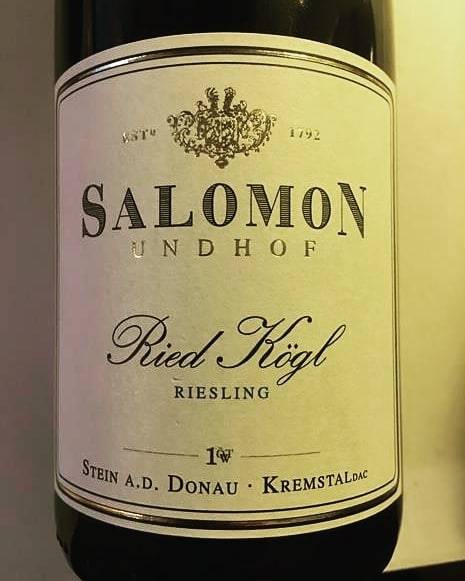
🇦🇹I have long been a massive fan of Austrian wines for a few reasons: Coming out of the shadow and sticking to its guns within a very short timeframe (first established DAC came in 2006) and moving towards the future with higher and higher quality wines of its own (few international varieties planted where local varieties thrive) [...] . ✔@salomonundhof has been one of the leading voices for that change. Located in the heart of the Kremstal DAC in lower Austria on the Danube, established in 1792, this family estate never fails to impress me. . 🍇Solely focusing on 2 grape varieties very dear to the area, Riesling and Grüner Veltliner along with being a new member to the Osterreichiche Traditionsweingüter, very few names have taken Austrian wine on the world map as much as these guys [...] . ✅Believer of a Burgundian approach (single vineyard wines) with high proportion of stainless steel tanks and some large neutral oak barrels, very strict vineyard selection is also achieved [...] . 🍀Ried Kőgl shows Riesling shining at its best. Great freshness, stoniness and stone fruits showing. On the palate, honeydew melon, canned peach and again amazing salty touch. Bracing acidity. Does so well at showing how balanced Riesling still is grown in a warmer climate. Young pup🐕 . @fannymariesalomon @domaenewachau @austrianwineuk @austrianwine @austrianwineusa @theaustrianwineblog @organicwineaustria @wsetglobal #rieslingwine #riesling #rieslingrocks #grunerveltliner #grünerveltliner #austrianwine #austrianwines #österreich🇦🇹 #kremstal #kremstalwine #kamptal #wachau #vineawachau #erstelage #grandcru #premiercru #vindumonde #viticulture #winemaking #niederosterreich #grossesgewächs #winetasting #winereview #wineblogger #wineblog #wineporn #wineevent #worldclasswine #vineyards (at Salomon Undhof & Estate) https://www.instagram.com/p/B2lqXRlC2IR/?igshid=msxt64ronoij
#rieslingwine#riesling#rieslingrocks#grunerveltliner#grünerveltliner#austrianwine#austrianwines#österreich🇦🇹#kremstal#kremstalwine#kamptal#wachau#vineawachau#erstelage#grandcru#premiercru#vindumonde#viticulture#winemaking#niederosterreich#grossesgewächs#winetasting#winereview#wineblogger#wineblog#wineporn#wineevent#worldclasswine#vineyards
0 notes
Photo

🇦🇹I have long been a massive fan of Austrian wines for a few reasons: Coming out of the shadow and sticking to its guns within a very short timeframe (first established DAC came in 2006) and moving towards the future with higher and higher quality wines of its own (few international varieties planted where local varieties thrive) [...] . ✔@salomonundhof has been one of the leading voices for that change. Located in the heart of the Kremstal DAC in lower Austria on the Danube, established in 1792, this family estate never fails to impress me. . 🍇Solely focusing on 2 grape varieties very dear to the area, Riesling and Grüner Veltliner along with being a new member to the Osterreichiche Traditionsweingüter, very few names have taken Austrian wine on the world map as much as these guys [...] . ✅Believer of a Burgundian approach (single vineyard wines) with high proportion of stainless steel tanks and some large neutral oak barrels, very strict vineyard selection is also achieved [...] . 🍀Ried Kőgl shows Riesling shining at its best. Great freshness, stoniness and stone fruits showing. On the palate, honeydew melon, canned peach and again amazing salty touch. Bracing acidity. Does so well at showing how balanced Riesling still is grown in a warmer climate. Young pup🐕 . @fannymariesalomon @domaenewachau @austrianwineuk @austrianwine @austrianwineusa @theaustrianwineblog @organicwineaustria @wsetglobal #rieslingwine #riesling #rieslingrocks #grunerveltliner #grünerveltliner #austrianwine #austrianwines #österreich🇦🇹 #kremstal #kremstalwine #kamptal #wachau #vineawachau #erstelage #grandcru #premiercru #vindumonde #viticulture #winemaking #niederosterreich #grossesgewächs #winetasting #winereview #wineblogger #wineblog #wineporn #wineevent #worldclasswine #vineyards (at Krems, Niederösterreich, Austria) https://www.instagram.com/p/B2lpX7mCFYW/?igshid=19xh01smtvh0m
#rieslingwine#riesling#rieslingrocks#grunerveltliner#grünerveltliner#austrianwine#austrianwines#österreich🇦🇹#kremstal#kremstalwine#kamptal#wachau#vineawachau#erstelage#grandcru#premiercru#vindumonde#viticulture#winemaking#niederosterreich#grossesgewächs#winetasting#winereview#wineblogger#wineblog#wineporn#wineevent#worldclasswine#vineyards
0 notes
Photo

🌱 ORGANIC WINES 🌱 . What's the big fuss about Organic wine?🍇 . ➡️Head on over to my IGTV up above to find out about this much talked-about topic🎆 . Today, we cover the basics and main principles of Organic wine but most importantly: - Should you care?🤓 - Do organic wines taste better?😛 . All questions answered in this new segment✌ . #wineblog #wineblogger #sommlife #sommelierlife #vineyardlife #vineyardpictures #organic #organicwine #substainableliving #biodynamicwine #naturalwine #farming #viticulture #biodiversity #frenchwine #italianwine #wineeducation #nicolasjoly #betterfuture #wineporn #winelegend #winevideo #wineregion #winereview #winenotes #winetasting🍷 #winetourism @organicwineexchange @pullthecork @demeter_de @austrianwine @my_wine_notes @keepwinedope @annaraym @icy_liu_ @the_kid_cat (at Grenoble, France) https://www.instagram.com/p/BvmirE4niX0/?utm_source=ig_tumblr_share&igshid=x10bnwyxh5xf
#wineblog#wineblogger#sommlife#sommelierlife#vineyardlife#vineyardpictures#organic#organicwine#substainableliving#biodynamicwine#naturalwine#farming#viticulture#biodiversity#frenchwine#italianwine#wineeducation#nicolasjoly#betterfuture#wineporn#winelegend#winevideo#wineregion#winereview#winenotes#winetasting🍷#winetourism
0 notes
Text
Barbera d’Alba 2017 Elio Altare

Elio Altare, natives of the tiny La Morra in the Barolo area first established itself by buying off 5 hectares, among other fruit crops.
But it wasn't until an eye-opening learning trip to Burgundy in France that his interests and focus for winemaking were sparked.
Back in the area in 1976, Elio decided to make radical changes.
Later On, the family's legacy passed hands in 2006 to Elio's daughter, Silvia. And since she has seen herself take ownership and bring a fresh new wave to the Estate.
Indeed today, very little intervention is done throughout the vine growing season (expect keeping the plant in a healthy position using organic compounds) or in the cellar(low sulphur use and wild yeasts), favoring rather vineyard expression and letting the wines take their natural path.
Farming today a small 10-hectare holding, Elio Altare has climbed its way to one of the most respected growers of Barolo in just over 50 years.
The wine takes on a fairly concentrated purple hue.
Clocking in at 15%, the first whiff brings a bit of an alcohol kick. Then fades into fresh blackberry, blackcurrant jam and dried leaves in the background.
Bit of a mouthful, this is a much heavier and serious Barbera d'Alba than usual.
Although youthful, delivers greatly on the palate with wonderful silkiness, texture and high acids. Very much on the dark fruits and earthiness side.
I would just set this aside a few years for the alcohol and acidity to come together a bit more, but this is absolutely delicious as it is. Living proof of well-executed winemaking at its best👌
0 notes
Text
Steinert Grand Cru 2012 Domaine Rieflé

Domaine Rieflé, active in the area since the early 1700's recently went through a complete makeover when Thomas and Paul, the domaine's latest generation inherited the Estate.
One noteworthy fact is they completely switched to organic farming, as they saw the soil's health and restoring biodiversity as their priority in the making of high-quality wine.
Steinert Grand Cru covers a massive 65 hectares. Longtime-famous parcel sitting on top of town of Pfaffenheim, limestone helps Riesling and Pinot Gris shine on this site.
Bright golden hues with shiny appearance.
The wine has an immediate beeswax appeal on the nose, as if one had crushed candied fruits and dipped them in beeswax. Quite pretty and attractive.
Ripe figs, honeysuckle and slowly fades into earthy tones... Mushroom lift.
The wine gets a bit more broad and powerful, upon first tasting it.
Medium sweet, the result is a liquid that clearly conveys its picking conditions. Candied orange peels, sous-bois, mushroom undertones.
Average acidity and round sweetness still, a travesty it would be popping this open before a few decades of ageing, as the botrytis notes and sweetness could be toned down...
...To be paired with any richer dishes or desserts...
#alsacewine #vinsalsace #pinotgris #grauburgunder #vinsfrancais #frenchwine #alsacetourisme #grandcru #winereview #winenote #wineblog #wineworld #wineporn🍷
0 notes
Text
Präsentation der Traditionsweingüter 2018/REPORT
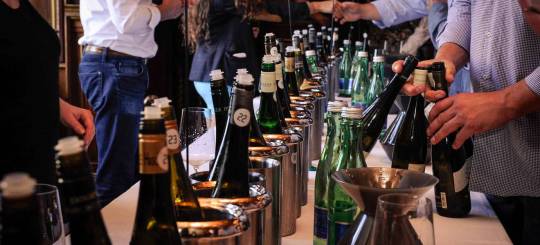
As a pretty big follower and overall dedicated fans of the wines of Austria, recently moved to the country, I immediately saw the new vintage release event of the Erste Lagen as something I could not miss out on.
Back in the 1990’s, what started as a tiny group of passionate winemakers in Kamptal/Kremstal under the name ‘Traditionsweiguter’ discussing vineyards and soils, later on turned into something much bigger;
Fast forward to present day, the organization has successfully brought surrounding winegrowing areas together under one roof, Osterreichische Traditionsweinguter. Now at 30+ members including Kamptal, Kremstal, Wagram, Traisental and more recently, Vienna.
...WHAT FOR?...

Indeed, as many reckoned the Burgundian pyramid system (Village, 1er cru, Grand Cru) as a success for preserving identity and terroir, this is the main goal the organization has intended to pursue down its path but more specifically: How does one map out individual identities within an old implemented system?
Well, they did just that. Setting out to promote and highlight every vineyard worthy of being granted a Erste Lage (Premier cru) or Grosse Lage (Grand cru) status. Although the Erste Lagen sites were finally revealed in the early 2010’s, the Grosse Lagen could still be another few decades.
As a matter of fact, this type of classification has led to the fame of certain sites such as Heiligenstein or Lamm in Kamptal, which the organization can be credited for.
...THE EVENT...
-Friday, September 7th 2018 was the day of the event (last day open to the public)-
...Set every year, the organization has set a rule for the new vintage not released to the market until the event taking place, which means all upcoming notes will be on the 2017 vintage...
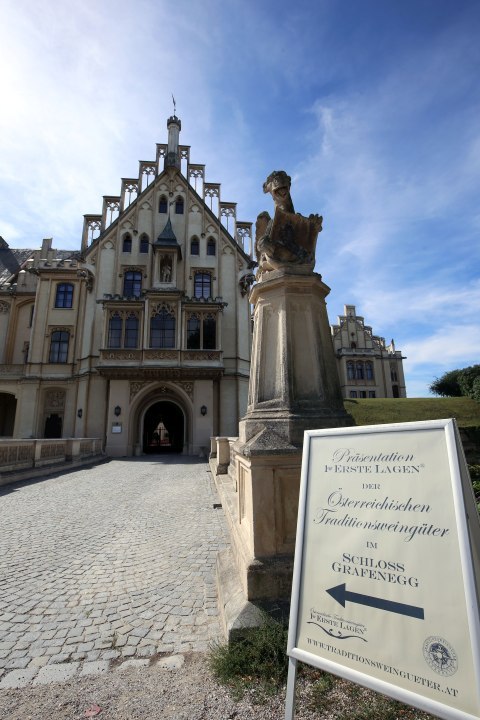
Set in a gorgeous setting out in the Kamptal area, I could not have thought of a better place than Schloss Grafenegg for hosting the event.
I’m immediately handed a glass as I walk in and make my way to the main hallway, where most producers could be found. Indeed, the event was spread around the castle into a few rooms and further divided into site names on each booth.
First off I have to say, hats off to the event planners people as this put the emphasis on the vineyard and not the winemaking team, also leaving room for comparison.
KAMPTAL/
I’m first greeted by the team from Hiedler, hosting the Heiligenstein booth, among other wines such as Jurtschitsch, Bründlmayer and Schloss Gobelsburg.

After about a few short conversations and what felt like half an hour of sampling, what I tasted were wines were of extremely high quality.
Most described 2017 as a very forgiving vintage, with long warm days throughout the season, which ended in rainy days closer to the picking date, leading to freshness and longevity in the wines.
Overall, what had me divided was rather immediate appeal vs. non-approachable, cellar worthy.
I found all wines, especially from Jurtschitsch to have an appealing, fruity aspect but found myself more attracted to the more obscure, youthful Riesling Heiligenstein from Hiedler… Quiet and closed but I would gladly come back to them in a few years.
KREMSTAL/
As I move further back to the Kremstal room, I notice a sudden decrease in space for producers as maybe for lack of fame? Who knows.
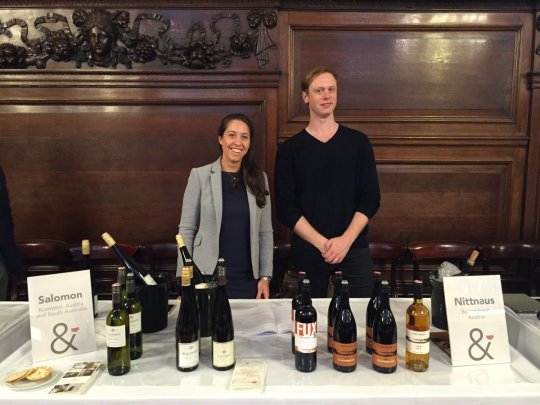
Looking around, I already had Stadt Krems and Salomon as the two names I wanted to taste from.
I then proceeded onto sampling through a lineup from both and although, Stadt Krems have remained among my personal favorites, here Salomon stood out.
Gruner Veltliner VON STEIN had to be the freshest and most pure GV I have had. Spiciness in the background but lifted by great acidity and moderate body (which most producers overdo). Great stuff.
All remaining Riesling, including Pfaffenberg were among other outstanding examples.
As most would compare the Kremstal climate similar to the one of the Wachau (also for its similar soil structure) and its wines at times heavy, I here found the complete opposite.
WAGRAM/
Last but not least in my limited amount of time, I managed to squeeze in one stop at OTT.
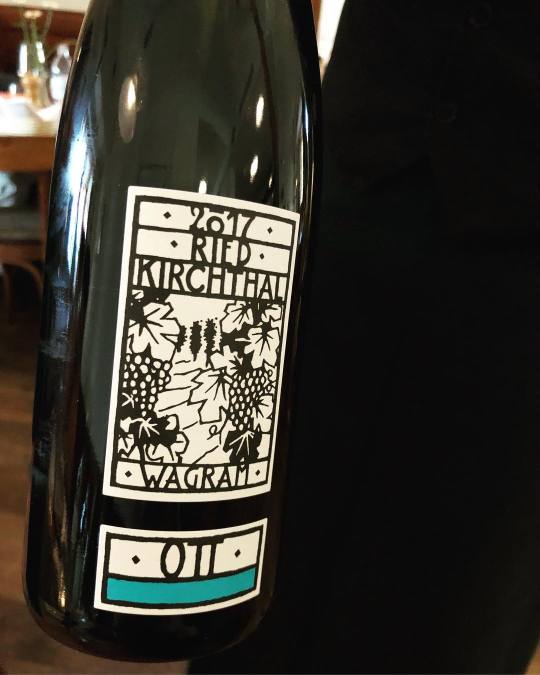
One of the famous names here, I believe in the Wagram having opened up to the world map of wine thanks to OTT.
Gruner Veltliner ROSENBERG again blew me away. Amazing freshness and laced with citrus peels, spices and well, warm welcomes go a long way!
...CONCLUSION...
I have to quickly make my way out, I wrap up this event on a upbeat note for wines to come from Austria and especially from these areas.
What came out of a few conversations was never has a focus been put so much on quality, care and identity from all producers. Based on what I had sampled prior to the event alongside all wines sampled, I cannot help but remain highly optimistic about the future of Austrian wine.
#austrianwine#osterreich#grunerveltliner#riesling#eventreport#tastingnote#winereview#wineworld#wineporn#wineevents
0 notes
Text
Weingut Gritsch (Wachau, Austria)

Grüner Veltliner Smaragd, Hochrain 2015
Textbook Grüner Veltliner here.
Sourced from a tiny 0.69 hectare, the warm South-facing HOCHRAIN vines (Spitz) are planted on layers of gneiss and loam, providing freshness and spiciness in Gruner Veltiner.
Starts off quiet yet discreetly spicy. Asparagus, fresh cut grass and spices on the backend. As I approached the wine a few minutes later, exotic spices were much more evident; Cardamom, allspice became the main focus as immediately appealing green flavors faded away.
Moderate acids, mouthcoating and powerful yet not heavy all throughout.
As numerous medias often describe Austrian GVs as monsters, I have never found the latter to be more wrong here. Full of freshness and superb.
Riesling Smaragd, Kalkofen 2015
This had to be one the most ‘knock out of the park’ Riesling I have sampled.
KALKOFEN of just over 4 hectares is located further down South in the Spitz area. With about a 75% slope incline, this particular site could be found nearly impossible to cultivate anything on without the use of terraces, or the winemaker’s never-ending dedication.
Mostly planted on gneiss, Riesling here thrives on those arid, poor soils.
Inviting nose drawing you in, dipping into lively cherry blossom and honeysuckle notes.
The wine then only gets better. Textured yet lively, juicy and crunchy all at once on the palate.
Stone fruits all around, this was picked at optimal maturity highlighting the varietal typical aromas; Gooseberry and lemon pie are among the few delicious things that come to mind;
Wrapped into fine acidity and great length.
Riesling are to be found all over Planet Wine, or in another words, all over the world but only a few reach that pinnacle point I personally came across with this producer… Especially with so little bottle-ageing.
#wachauvalley#austrianwine#osterreich#grunerveltliner#riesling#oldworld#wineworld#winereview#whitewine#weisswine#wineporn#winenotes#winetasting#beauty
0 notes
Text
Etna Bianco 2016 Ayunta

For those of you kindly keeping up with my weekly postings, I was recently ranting about the beauty of Etna and its ability to withstand against any classically-defined wine regions.
Although, Mount Etna had long been shaped by viticulture for centuries, it was not until the late 1990′s that investments or simply the Wine World figured out just how much potential Etna had.
Running Northeast to Southeast around the volcano, most of the area under vines are planted to Nerello Mascalese and Nerello Capuccio, creating the Etna Rosso blend, while Carricante and Catarratto makes for the blend created under the Etna Bianco DOC (although a small tiny amount of other indigenous grape varieties can also be found).
While most of the volcanic soils are phylloxera-free with vines approaching +200 years old, substantial differences were also found based on the site vines were grown in as microclimate drastically changes from one side to the other.
Indeed, the term ‘contrada’ was first struck in 2005 based on that belief, as producers felt the need to show and highlight how key sites were, as it is the case in Burgundy, France (Premier cru, Grand cru system).
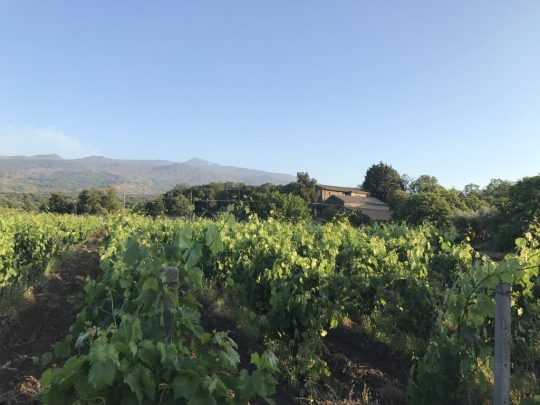
In other words, not only is Nerello Mascalese (as is Pinot Noir) extremely sensitive to site exposure but ripening conditions can prove difficult when the right conditions are overlooked (elevation, sun exposure, slope incline).
Back to this review, earlier this week, I happened to be lucky enough to experience what the region really has to offer in a liquid form.
Filippo Mangione, Ayunta’s founder, has had wine part of his life and his family’s for a little while.
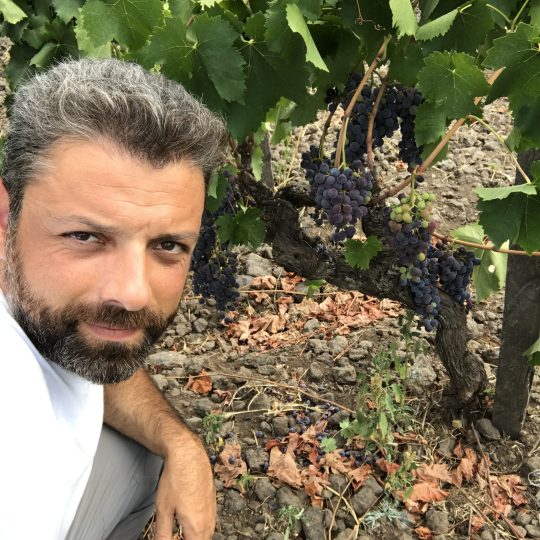
Growing up in Southern Sicily, Filippo watched his father tend vines since a very early age until witnessing his passing, which led to all of his family’s holdings being sold off eventually.
Following up was Filippo finding his way into the wine industry all the way to a sommelier position inspiring him to make a trip back to his roots down in Etna and take over what were, soon-to-be, abandoned parcels.
Fast forward to 2011, Filippo kickstarted AYUNTA with holdings from very old vines, primarily located on the Northern side of the volcano and today averaging 3 hectares.
Another noteworthy fact is, as these are also sitting on fairly high altitude in a cooler area, around 600-700m, harvest can be overdue and take place until the end of October for red varieties.
Filippo made it also very clear from the very beginning that very few interventions would be made in or outdoors and no chemicals would be in use in the vineyards over a yearly, very close watch on the vines instead.
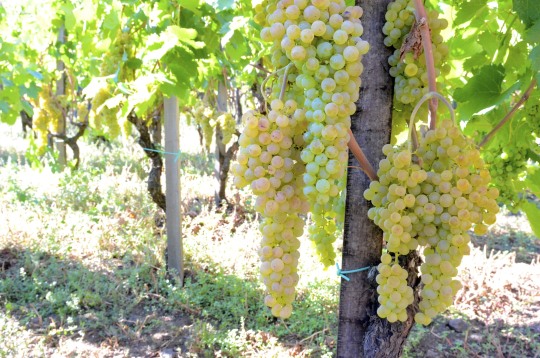
ETNA BIANCO ‘Piante/Sparse’, proudly displayed on the bottle here stands for ‘stray vines’ in Italian, as white varieties are blended in and scattered among red varieties. As a result, maturity can be tricky to keep in check and Filippo, in some years, prefer to not even release any whites on the market.
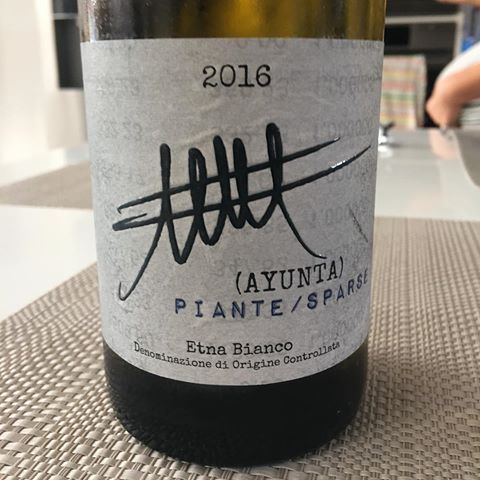
The wine, when poured, comes off a touch cloudy (not surprising as no filtration or fining is done) and extremely vibrant taking on bright gold hues and, if this can be a wine descriptor, glitters.
I found the nose to be living up to its color, again starting off extremely bold.
Most interesting of nose here. Changing as the glass was swirled around some more, making me feel like I was opening a spice cabinet… vanilla beans, cardamom and pistacchio, taking me to a seafood platter with some briny notes and wet rocks finishing off on some yellow apple flesh undertones. Never-ending.
Overall, I felt the wine dancing, tickling and evolving just under an hour (or enough time for three individuals to get to the end of the bottle). Great acidity throughout providing backbone and added roundness to the wine.
In all honesty, Craftsmanship can truly be tasted in here.
Whether this is in any ways related to the non-interventionist practises, I cannot confirm but this is nonetheless, in every way, very well-handled and again, is a reminder that Mount Etna has a bright future ahead.
Thanks for reading!
AA
#etnabianco#etnawine#volcanicwine#blogreview#winereview#wineblog#wineworld#winelover#ayunta#winetasting#tastingnote#italianwine#sicilianwine#sicily#italiavino#volcanowine#volcano#vineyards
0 notes
Text
Wines of Etna, Sicily - Overview

Among the few outstanding classic wine regions of the World, I’m still struggling to see full credits given to some over other overpriced and famous areas, which is to me extremely sad.
What does, you ask, a classic wine region fit into?
Well, I tend to mostly think of European regions as such with some historical relevance, winemaking legacy tied to the area or in another words, carrying some identity. So again, quite the blurry definition.
Nowadays, to most wine drinkers, Piedmont in Italy (Barolo, Barbaresco), Burgundy in France or Rioja in Spain, would most certainly be considered as such.
But what about other up-and-coming areas that have yet to get the proper recognition they deserve?
Yes, Etna, I’m talking about you.

Mount Etna in Sicily, remote archipelago just a boat trip away from mainland Italy, has sadly stolen the spotlight for erupting numerous times over the past decades and wiping out all traces of past civilization behind… Over its wine.
Although Sicily as an island was made famous in the 19th century for wine such as Marsala (West side of the island) or Passito di Pantelleria, a sudden drop in marketshare, interests around the WW2-era took place as fortified wine was falling out of fashion and wine such as Barolo, Amarone took over.
Fast forward to the 1980’s, although other under-the-radar areas saw investments coming in such as Angelo GAJA in Tuscany, looking for a cheaper alternative to estate expansions but somehow, most of Sicily remained unnoticed…Until the late 1990’s.
Vineyards, since the 1880’s, had been part of Mount Etna’s landscape but it was not until the late part of the 20th century that Mount Etna, as a wine region, had the chance to shine.
As well-established, powerful investors with a winemaking background moved down to Etna and purchased vineyards (F. Cornelissen from Belgium or M. de Grazia from Tuscany) while regional government started to funnel funds towards preserving Etna’s terroir in replanting its vines, suddenly interests grew.
But let’s focus on volcano talk.

Mount Etna is fascinating.
Today’s highest mountain in Italy South of the Alps, the volcano benefits from an extremely diverse terroir and very few grape varieties, only showing their true potential on highly-elevated vineyards.
Indeed, All of its area under vine curves around the volcano and cools down a bit up North, warming up as one makes its way down South.
With some of its highest vineyards up at over 1200m, day and night temperature gap become greater and the wines salty, crisper and almost crystalline…

Over time, as Mount Etna unleashed and left villages destroyed, it also spread lava, volcanic ashes and sand along the way, slowly covering all of its surrounding area and making it extremely fertile for winegrowing.
Indeed, as all other European regions had their vineyards wiped out to phylloxera along with Sicily in the 1950’s, Mount Etna was blessed with disease-free soils. Sandy-based volcanic soils indeed have properties keeping the bug away, which means that some of the highest-located vines today remained alive from back in the day and are approaching, for some, 200 years old.

By some, the area is also sometimes looked at as Burgundy as location for growing grapes around the volcano is key and all of historically-grown grape varieties have remained the same over centuries.

Today, mainly two styles of wine can be found on Mount Etna.
--> Etna Rosso DOC: Made of a blend of Nerello Mascalese (80-95%) and Nerello Cappuccio (5-20%), this has come to be the ‘classic’ flagship style of wine for reds.
N. Mascalese brings the power and grittiness while N. Cappuccio color and softer aromas.
Extremely compelling bottlings can be found today (some of them on ungrafted vines) delivering on the power, juiciness but mostly finesse and subtlety of the blend:
TENUTA DELLE TERRE NERRE - Prephylloxera
BENANTI
FRANK CORNELISSEN
AYUNTA
GIROLAMO RUSSO

--> Etna Bianco DOC: Focused here on the Carricante (60-100%) and Catarratto (0-40%) blend, both extremely old varieties.
Wines, in this case, stand out for their light citrus peel aromas, quietness, saltiness and high acidity (depending on winemaker style and location for site).
Carricante comes in here as the main grape for flavor compounds and high acidity, while Catarratto rounds it out and brings balance to the blend:
BENANTI - Pietra Marina
PIETRADOLCE
AYUNTA
TENUTA DELLE TERRE NERRE
PLANETA
As a side note, Etna Rosato and Etna Spumante (mostly made of Nerello Mascalese) can also be found today but very little is produced every year, as producers tend to put an emphasis on Etna Bianco/Rosso.
If you haven’t been sold on the region yet, I please beg you to book a tour around the vineyards and the area as what better vacation than wandering around an active volcano followed by wine tastings?
I would maybe just pull away from being anywhere the volcano on eruption day.

As I mentioned before, the area is very much on the rise as expansion is underway, winemakers fine-tune their style and wines make their marks on the market, so patience is key here.
Thanks for reading!!
#etnarosso#etnabianco#volcanicwine#italianwine#sicilianwine#sicily#wineblog#winereview#winetalk#volcanowine#islandwine#italiavino#etnawine#mountetna
0 notes
Text
Barolo 2008 Fontanafredda

One thing for sure is, it is about time I finally get some coverage of the wine world's legends up on this blog.
Barolo and Barbaresco, respectively King and Queen of Piedmont have long been part of the area’s natural scenery. Nestled on both sides of the town Alba, South of Turin, both appellations have been subjected to countless changes, wars but one thing that has never been so strong is quality and dedication from its most committed winemakers.
Having built and shaped a longtime reputation around a single-grape variety mostly, Nebbiolo. Late-ripening, hard to grow and sensitive to its site grown in, the latter can take on multiple profiles, influenced by surrounding elements, as it is the case in Barolo and Barbaresco.

Usually, undertones of rose pedals, black cherry but also leather, black tea and anise notes are typical tasting notes found in the grape variety.

Barolo, just Southwest of Alba, is a bit further inland while also lower closer to sea level. Most of the vineyards being South-exposed and with longer sunshine hours, the grape tend to take here on a much sturdier, grippy but extremely elegant profile. Usually taking years to develop and open up.
On the other hand, Barbaresco, Northeast of Alba has most of its vineyards closer to the nearby body of water, Po river or at its best, gets influenced by it. As a consequence, tannins tend to be slightly softer and the wine more easily approachable in its youth (examples can vary though).
Let’s take a closer look at Fontanafredda in Serralunga d’Alba, Piedmont.
FONTANAFREDDA shares a deeply rooted history of winemaking in the area going all the way back to 1858.

In fact, the Estate started on a fairly big scale at no less than 300 hectares and gradually expanded until crises arose and phylloxera (1928) and the Great Depression (1929) took its toll, leaving the family having to sell off their ownings to a local bank at the time (1931)...
Until the family got its hands back on it in 2009 and completely revamped all facilities and putting the once-forgotten Domaine on the world stage again (building an hotel, restaurant, wine bar, foundation etc).
Located in the Serralunga d'Alba subzone (Southeast of the Barolo appellation) where wines there can take on a powerful yet extremely fine profile, Fontanafredda's current 120 vineyard holdings start at a 10-hectare sized parcel surrounding the main winery as well as another 100 hectares further down in the area. This Barolo 2008 was sourced entirely from vines surrounding the Estate from the 'FONTANAFREDDA' single-vineyard. Although 2008 as a vintage was not critically acclaimed at the time because of lower concentration and higher acidity levels, this baby seems to have clearly come around after about a 10-year long bottle ageing. Decanted a few hours ahead of tasting. Garnet-colored with ruby on the rims, the first whiff on the nose starts off fragrant yet quiet, taking on a bit of musky smell and developing into waves of fine rose pedals, black tea leaves led by a well-defined yet subtle dark cherry core. Following through and hitting with leather, dark cocoa and dried salami notes, this gem kept on getting more complex as it opened up. I would, for once, almost put this wine in the 'mature, at its peak' category as all elements seem to have all come together into this refined and coating texture that Barolo can only achieve over patience and long-cellaring time.

Thanks for reading!!
A.A.
0 notes
Text
Domaine Coursodon St.Joseph

“I never once considered doing anything else” were Jérôme’s first words (4th generation winemaker) upon being asked about what had gotten him started in the first place. This was one of our first encounters and I cannot say I’ll forget his words anytime soon.
Domaine Coursodon is indeed an estate rooted in history in its own rights.
Antonin Coursodon and his father Jean-Auguste, first founded the Domaine in the late 19th century and in many ways, helped pave the way for what most people know St.Joseph as it is nowadays.
Although, first records of vineyards and wine in the area being made was recorded as far back as 1688 under the name ‘Vin de Mauves’, it was not until 1956 that the appellation was well-defined under a stricter set of rules or AOC.
Antonin, indeed was not gifted with the most conflict-free century to get everything up and running, struggling to make ends meet as the phylloxera crisis was just around the corner.
Another thing to bear in mind was, whether in the Northern Rhône or most of the wine world, wine had not made it as a huge global trend just yet, which means that most winemakers at the time not only produced wine but had equal interests in nurturing peach, apricot and cherry crops.
In other words, more means and further ways to make a living out of helped keep the farmer on its feet when times were tough.
But as one would say, as one problem struck, more were to come…
Heading into the first decade of the 20th century and while most winemaking areas in France and Europe were just started to recover from the phylloxera wipeout, resources and backstocks were becoming scarce as conflicts arose and WWI hit, putting winemakers’ livelihood on a thread.
As a result, this led to what most consider the ‘blending-era’.
As there was not much wine to go around and put out on the market, a lot of what sold under a single name (Châteauneuf-du-Pape) was actually sourced from a few different places and blended together in order to meet demand.
What this did was leading to general public confusion but mostly a fairly significant drop in quality for what some had fought for centuries.
This is where the Institution des Appellations d’Origine Contrôlée (INAO) came about as the main nationwide body of regulation but so what had just happened could further be avoided through strictly implemented regulations, drawing not only geographical borders for all French appellations but giving them accurate rules for winemakers to follow including yields, harvest and such.

Jumping back to Domaine Coursodon and St.Joseph, the appellation was given one of the latest AOCs to be implemented in 1956, just under 100 hectares of vine with its original area stretching to six villages, Chateaubourg, Glun, Mauves, Tournon-sur-Rhône, St-Jean-de-Muzols and Vion.
Following pressure from a growing demand as well as an increasing number of newly planted vineyards outside the original area, the appellation was extended in 1971 and capped at 3000 hectares in 1994, today currently at 1200 hectares under vine.
And while all of the now 20+ year-old expanded area goes under the name ‘St-Joseph’ on a label, the original six villages (adding up the already well-established list of longtime producers there) are widely known for producing some of the most complex and long-lived wines.
Domaine Coursodon, which up until the 1980’s owned only 5 hectares in the area, has gradually grown over the years into a well-established 16 hectares operation. Starting in Glun, vineyards can also be found just above the village of Mauves but also Tournon and St-Jean-de-Muzols, further North up the Rhône river.

Bottlings from the Domaine can be sourced from all types of soils from low-water retention limestone, pebbles to decomposed granite but the most compelling examples can be found on the latter on South-exposed head-spinning steep hillsides. Some parcels, especially in St-Jean-de-Muzols, even share similarities with vines planted on the Hermitage hill, being very geographically close by.
Absolutely stunning and deeply rooted in history, those can nevertheless be backbreaking and require higher hands-on involvement and dedication year in year out. The slope incline is indeed one factor that make the use of mechanical tools impossible and almost all vineyard labor across the growing season is carried out manually.

Upon working alongside Jérôme although no biodynamic or organic certification is in the works, a clear acute awareness for general vineyard health is what is driving his every move. He indeed leans towards a more ‘Lutte Raisonnée’ approach as little pesticide spraying is done unless needed, as he believes keeping vines healthy and putting them in a position so setbacks can be avoided, is the best way to look out for them.
Today, Jérôme very much strikes me as a modern traditionalist. Let me explain myself here.
As some older-generation producers stick with decades-old practices, Jérôme is a firm believer of year-round dedication in the vineyards and good phenolic maturity as it, he himself puts it, best expresses the ‘terroir of the appellation’.
He also, down in the cellar, relies on a blend of new oak barrels (260 litres) sitting alongside demi-muids (traditional 600 liters barrels from the area) as well as stainless steel, used mostly for his entry-level bottlings.
What is following down below is a flight of barrel sampling (from wines soon to be bottled) across multiple vintages.

R/ SILICE (100% SYRAH), made from a blend of different limestone-based parcels (Mauves, Tournon and Glun), fermented in stainless tank, open-vat fermenters and aged 12 months in demi-muids:
2017—> Although different samplings were done from multiple parcels which would later go into the final blend of ’Silice’, focus was made here on the softness of the Syrah grape, and while crunchy and grippy at times, I found fragrant violet notes, freshly picked black fruits and black liquorice with great acidity. Drink now!
R/ L’OLIVAIE (100% SYRAH), made from older vines on a steep, granite-based, single-vineyard in St-Jean-de-Muzols, aged 15 months in 85% demi-muids and 15% new oak:
2017 —> A bit more concentrated, this to me falls into meat-based pairings as this definitely is a more serious, dinner wine. A bit more viscous, which will probably tame with age. Crushed blackberries, black currant, bramble and a lingering earthy and peppery edge. Long-ageing potential.
2012 —> Absolute beauty. This was not supposed to be part of the flight but great surprise upon opening. Difficult year at first but evolved amazingly. Great concentration while keeping a fine line of balance all throughout. Wet leaves, touch of forest floor all came together with a beautiful fragrant black currant core. Drink now.

R/ SENSONNE (100% SYRAH), made from a blend of different parcels on granite soils, aged 15 months in 100% new oak:
2017 —> A bit more impact of new oak felt but good balance overall. Delicious black fruit core, linced with cloves, cinnamon and garam marsala, wet rocks and long finish. Long ageing potential.
R/ PARADIS St.PIERRE (100% SYRAH), flagshig bottling of the Domaine, made from a amphitheater-shaped single-vineyard overlooking the town of Mauves, granite soils, aged 15 months in 80% demi-muids and 20% new oak:
1996 —> Another completely unexpected surprise. This definitely took some time to open up but revealed leather, tobacco notes, subtle wild blueberry fruit. Still incredibly lively at this stage, balsamic vinegar and marzipan undertones. Great complexity. Drink now.
2003 —> Heat wave hit the area hard but was amazingly handled inside the winery. A touch more concentration here, stewed black fruits dominate with bramble, dry violets and wet rocks notes. Long finish. Drink now.
W/ PARADIS St.PIERRE (95% MARSANNE, 5% ROUSSANNE), same single-vineyard overlooking the town of Mauves, aged 12 months in 80% demi-muids and 20% new oak:
2017 —> Again, multiple samplings were done from barrels scattered around the winery but most of the stony fruit side of the Marsanne/Roussanne blend was showing. Apricot and nectarine flesh, acacia flowers, sunflower seeds with rich mouthfeel. Decent acidity.
This wine has layers and layers coming through and strongly screams for food. Long ageing potential.
#stjoseph#frenchwine#vinfrancais#syrahwine#northernrhone#wineblog#winereview#review#blog#domaine#wineworld#sommlife
0 notes
Text
Northern Rhône Valley - Overview
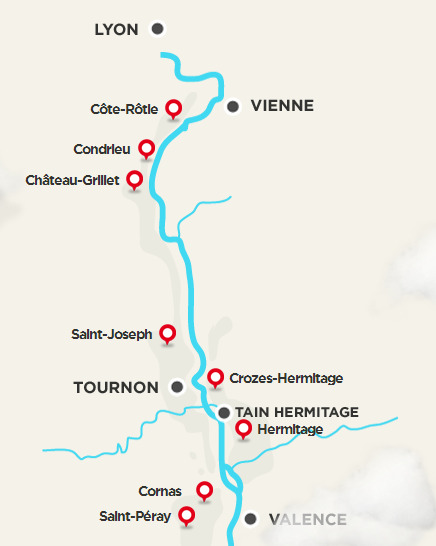
Well, I think the time has come for me to write about the Great Wines (notice here both capital letters) on this planet Earth, which one would make a mistake not starting with the Rhône Valley as one of them.
Geographically, the valley runs its course North to South, etched into the cities of Vienne to the North and Valence to the South, over a 60km stripe total.
Starting West to the Rhône river, the town of Ampuis rises up, where most of the Côte-Rotie vineyards can be found. Moving down to the town of Condrieu, Vérin for Château Grillet, St. Joseph all across a good portion of the stripe between Chavannay and Glun. Then, Cornas followed by St-Péray, which closes our little tour of the area.
But first, let’s look at the grapes and the appellations a bit more in-depth, just to get everyone on the same page.
Coming to the number of 4, they all share the Northern Rhône Valley as their birthplace: Syrah, Viognier, Marsanne, Rousanne.
CÔTE-ROTIE (established in 1940)
Côte-Rotie, mostly based around the town of Ampuis, has a staggering acreage of 276 hectares, the second biggest in the area but still one of France’s smaller appellation in terms of hectares grown.
Over the years and especially in the past few decades, not only being of the most age-worthy wines with best examples going back decades, the appellation has built itself a worldwide reputation upon two grapes, Syrah and Viognier. Although it might seem counter-intuitive to blend both red and white grape together (up to 20% of Viognier can be added to the blend), the white grape can actually bring a daunting floral-edge and an amazing finesse that most wine drinkers will die for.
While it might share similarities with other Syrah-based appellations in the area but nothing quite compares to the black fruit core, spiciness, black pepper undertones but mostly being bold and never overwhelming.
Having 73 registered crus today (Côte Blonde and Côte Brune being the two famous ones), the appellation has historically always been known for blending parcels together in order to produce a more even expression of the terroir, making the single-vineyard bottlings a more modern approach.

Vines are planted on steep terraces where North to the center part of the appellation, clay-based soils can be found which gives wine its power and moving down South of the appellation, sandy-granite soils are most common, known for its floral aromatics.
Today, the appellation is known for its incredible concentration of worldclass producers but here are my own recommendations for producers to hunt:
R. Rostaing
P. Jasmin
E. Guigal
JP. Jamet
Gangloff
Yves Cuilleron
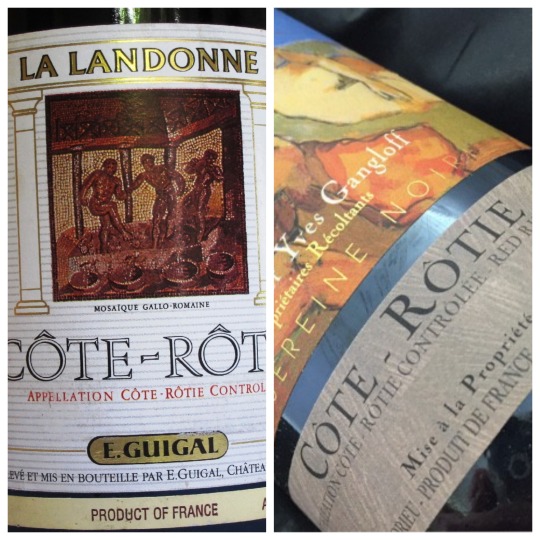
CONDRIEU (established in 1940)
Under 110 hectares of vines today, made of 100% Viognier grape, Condrieu can be rich, silky, greatly textured and full of exotic spices but still remains today somewhat of a niche appellation as not a lot of it is exported outside of Europe or even outside of the area.

Planted on steep terraces and spread around the tiny village of Condrieu on Schist soils, Condrieu wines can be a rarity enjoyed within a few years of release, as the grape is mostly picked at a higher maturity, which keeps acidity levels lower than most wines (also being a lower-acidity grape). Can be at its best, textured and balanced and at its worst, opulent and cloying.
Recommended producers:
G. Vernay
Les Vins de Vienne
Domaine Faury
Gangloff
F. Villard

CHATEAU GRILLET (established in 1936)
Extremely tiny appellation registered as a monopole of over 3 hectares under vines (single-owner, one of three in France).

100% Condrieu, Château Grillet is based out of Vérin, just a few kilometres down the town of Condrieu and tend to be a bit off the beaten path. With a small 10 000-yearly production of cases a year, the Estate keeps a very close watch on its wines and how it is sold to its buyers while most of it go out to auctions today.
The Estate, whose Thomas Jefferson was a big buyer of, has a history that goes back hundreds of years. The property was owned by Neyret-Gachet family from 1887 to 2011 and was most recently sold to François Pinaud’s multinational firm, while projects are currently underway.

And yes, being as highly-priced as it is, C.G was pointed out a few times to be inconsistent on some vintages but these wines are longer-lived than most of Condrieu wines and can have an incredible depth with some beautiful honeyed, stone fruit and mineral notes.
ST. JOSEPH (established in 1956)
St. Joseph has a long history for winemaking and has to be the most value-driven/popular appellation out of the area and for good reasons as its quality has been on the rise for the past few decades.
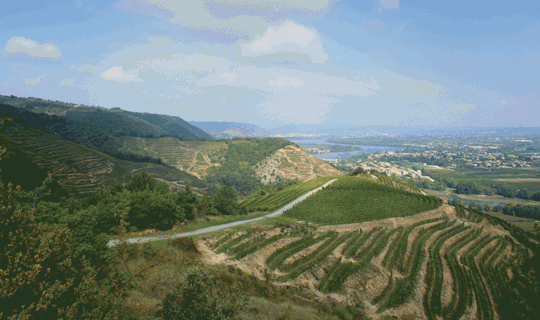
Planted to Syrah, Marsanne and Rousanne on steep terraces, the appellation started North of Cornas in 1956 around the towns of Glun, Mauves and St-Jean-de-Muzols at about 100 hectares to later expand in 1988 to the rest of the valley, up to Condrieu into a staggering 1200 hectares today.
St.Joseph white and red can both be found today and it still remains one of the most beautiful expression of Syrah as a grape variety, if well-handled.
A wave of producers can be found today producing the wines and can be a hit-or-miss, meaning berries picked too ripe by unexperienced hands can sometimes come out a bit jammy and unfocused, almost New World-style.
But can shine, especially on wonderful vintages like 2015-16-17 from worldclass producers... Producing for the reds, seamless, fresh black fruit mineral-driven while retaining a spicy and floral tone and for the whites, rich but floral.
Recommended producers:
Domaine Coursodon
R. Trollat
Domaine Faury
P. Gonon
B. Gripa
Domaine Jean-Louis Chave

CROZES-HERMITAGE (established in 1937)
Jumping East to the Rhône river, Crozes-Hermitage can be found on flatter parcels, from both white and red grapes and has over 1500 hectares under vine.

Equally as popular nowadays partly due to the prestige of the ‘Hermitage’ name and its neighbouring hill, Crozes-Hermitage covers the whole area surrounding the latter.
Along the lines of St. Joseph, the appellation can be found on both sides of the spectrum at very ripe levels with lower acidity. which also means easily approachable and drunk at a young age, although a few reliable exceptions can be found down the line. I would stick to producers’ names as a rule of thumb.
Recommended producers:
N. Chave
A. Graillot
M. Chapoutier

HERMITAGE (established in 1937)
Probably the number one most famous and prestigious appellation where it all started back in 600 B.C.

Especially as one knight back from the Crusades was offered a hill as a gift from the Queen for him to retire and spend his last days. Making him known as the ‘hermit’ where he then started planting a few wines which kickstarted viticulture in the region, later on giving the appellation its renowned name Hermitage.
Overall, 130 hectares of vines of Syrah, Marsanne, Rousanne are planted on much more sandy and granite-based soils with much longer sunshine hours due to South-facing slopes, which makes for much heavier wine clearly not meant for early consumption. They can open up beautifully over 10-20 years into much smokier, peppery and fragrant beauties. Much more austere and rustic than Côte-Rotie.
Today, it seems like the wines have somehow fallen under the radar a bit and are losing ground over other surrounding appellations. Although a few bottlings are worth pointing out, especially from JL. Chave or l’Ermite from M.Chapoutier.
Recommended producers:
JL. Chave (Cuvée Cathelin)
M. Chapoutier (l’Ermite)
Delas Frères

CORNAS (established in 1938)
Just south of where St.Joseph ends West of the Rhône river, the small 130 hectares of vine planted to Syrah ONLY (by far) makes for the most tannic versions of the grape found in the Northern Rhône Valley. Although some producers are slowly making changes in style, polishing its edges a bit (with shorter maceration time) and leaning towards a more appealing approach to making Cornas.

A bit further away from body of water on very steep granite soil, some sites don’t quite get the cooling effect that the Rhône river can bring to other appellations, creating a particularly warm microclimate for vines to grow in.
But one thing that Cornas has never failed at is delivering. The wines can indeed have some weight and coarse texture yet maintaining lively acidity with layers of stewed black fruits and smoked meat notes. Being to this day one of the AOCs stating the strictest rules for winemakers to follow, the appellation is packed with producers delivering incredible and consistent quality year in, year out.
Recommended producers:
A. Clape
T. Allemand
Domaine Lionnet
M. Barret
Domaine du Tunnel

ST-PERAY (established in 1936)
Having made our way all the way down South across the valley, the road gradually start taking on a much flatter aspect as it opens up to the city of Valence.

Edged into both towns of Valence to the South and Cornas to the North, the appellation under 75 hectares of vine is primarily dedicated to growing white grapes, Marsanne and Rousanne. The production there remains fairly small and not much makes it outside of local consumption while the wines commonly sees barrel-ageing, although a touch more delicate than most of the other whites found in the Northern Rhône Valley. The grapes are most commonly picked earlier with higher acidity levels and tend to produce white wines with a bit more energy to them.
Grapes are usually blended together. Marsanne, a grape with much stronger aromatics gets offset by the floralness of the Rousanne, much more delicate of a variety.
Also, it is worth pointing out that not only exciting still but sparkling wines have recently made headways and have historically been made in the Traditional method.
Recommended producers:
A. Clape
Domaine Alain Voge
B. Gripa
Les Vins de Vienne
Pierre Gaillard

Anyways, if you still didn’t get the point I was trying to get across, the Northern Rhône Valley is today one of highest-quality areas for wine production all across the Globe and has never failed to amaze as producers never cease to question styles being made, while making sure to deliver year after year.
TIME TO GO GET SOME, and please I would highly recommend cruising around the area and get a feel for what the valley has to offer. Plus, most winemakers are incredibly welcoming and happy to share their wine!
Thanks for reading!
AA
#cornas#stperay#coterotie#condrieu#chateaugrillet#stjoseph#hermitage#crozeshermitage#redwine#rhonevalley#frenchwine#blog#review#wine#winelover#sommlife
0 notes
Text
Les Vieux Clos 2015 N. Joly

Loire Valley Wines! The more I think about it, the bigger of a market share I feel like this area has gained in the wine world over the past few years.
How did that happen? Great question.
Well, there has been quite a renaissance of producers happening, making their marks and leading the way for newer generations to follow, including Domaine Huet in Vouvray, Domaine de l’Ecu in Muscadet-Sèvre-et-Maine or Nicolas Joly in Savennières. Following their guts all along, putting an emphasis on the ‘terroir’ aspect of their wines and crafting timeless beauties over the years is what, to me, has made the Loire Valley an even more relevant of a wine region.
Nicolas Holy, although starting his venture in the Finance field, found himself taking over his parents’ vineyard holdings in 1977 and is wildly recognized today as one of France’s most dedicated and proud advocate of biodynamic practices.

What came out of this was a deep passion and respect for his surroundings, like treating his own child.
Savennières, located in the Anjou area of the Loire valley in Northwestern France is today one of the Loire’s famous appellation for producing dry to off-dry 100% Chenin blanc wines among other surrounding appellations Coteaux du Layon, across the Loire river, with its sub-appellations Bonnezeaux and Quarts-de-Chaume (famous for dessert wines) along with the most generic, wider Anjou appellation.

All of these, although producing high-quality Chenin blanc-based wines, does not quite reach Savennières and its two sub-areas, Clos de la Roche aux Moines and Clos de la Coulée de Serrant, concentration of wordclass producers and brilliant handling of the grape.
The appellation is also known for being capable of producing powerful wines, as the local climate not only allows for optimal maturity but also botrytis.
Nicolas Joly, although unconventional, does believe in achieving Chenin blanc’s full potential by reaching full maturity of the grape and harvest being done in a few rounds, up to Mid-November in some years.
All wines are fermented and matured in old casks with very little sulphur and only slight filtration.
LES VIEUX CLOS, one of N. Joly’s 3 bottlings of the Domaine (Clos de la Bergerie, Clos de la Coulée de Serrant, Les Vieux Clos) is sourced from a 5.5 hectares parcel out of 20-year old vines.

2015, was also known in Savennières for overall producing very balanced wines as a vintage, as good temperatures were reached throughout growing season with very little botrytis.
This wine, on the color, does give off a very cloudy aspect (as the wine is only slightly filtered), almost reminiscent of a much older white wine, as older Gruner Vetltiner or Riesling can evolve.
Evolving towards deep gold-amber tones on the rims.
On the nose, this wine strikes me as ‘ backwards’ and took quite some time to open up (decanting 48h ahead is usually recommended).
Started on aromatic yet unripe orchard fruits, as it opened up, marzipan notes started to take over followed by waves of spices coming through… Saffron, vanilla beans, garam masala while carrying baked apple pie and strong quince notes Chenin blanc is well-known for.
Notes on the palate carried well all the way through again with strong orchard/spicy notes with a grippy yet coating texture to the wine. Great acidity providing backbone to the wine and finishing strong.

This, in other words, is a beast that only needs to be tamed… How, you ask?
Long decanting time but mostly long cellaring time as this is no doubt an age-worthy wine that has decades ahead.
Also, please do yourself a favor and make a quick stop by the butcher for food pairings as this beast needs to be treated as a red wine and will take over all lighter dishes.
Thanks for reading!!
A.A
0 notes
Text
Côte-Rotie V.V 2015 C.Billon

As some of you may know, getting access to wines produced in the very region where one lives tend to be a much easier process which, also tend to lead to a much wider selection as a whole. Pretty amazing, right?
You don’t say and I do consider myself lucky then. Let’s make a quick jump in time before I jump into our review.
With my move back to France from Toronto, long story short, came the opportunity to further my viticulture and winery-related knowledges by working for Domaine Coursodon up in St. Joseph. (obviously, including some applying vs. interview deal, but it all worked out).
Which brings me to today’s review.
Tain-l’Hermitage, located in the heart of the Northern Rhône and across the Rhône river from the Hermitage hill, is probably everybody’s first introduction to the area and also where I’ll be reviewing today’s review from.
Domaine Billon, recently introduced to the very well-stocked Côte-Rotie producers portfolio, found its way in the area selling grapes primarily as a négociant to E. Guigal in Ampuis before purchasing their own sites and is still being developed today.
Côte-Rotie, at the very Northern end of the Rhône Valley, very famous AOC where viticulture was introduced in Roman Times, gradually grew famous for its Syrah (up to 95%) vs. Viognier (up to 20%) blend and although producers style can vary, that elegance Côte-Rotie is known for has stood true to the test of time.
Here, we have a 95%, 5% blend from multiple sites on old vines, up to 30 years old. On another note, 2015, along with 2016 and 2017 have been known for being magic vintages in the area so let's see how this is delivering.
Visually, the wine takes on a darker-ruby tinge and developing into a light-ruby/purple on the rims, leaving quite a coating feel.
On the note, one thing that hits me is that fragrant, freshly-picked blackcurrants/blueberries edge to the wine while also noticing some pretty intense spice box feeling… Paprika, curry and almost vanilla beans, suggesting a larger proportion of new oak here.
On a second whiff, strong floral and lilac/wet violet notes rise up with a slight stone fruits feel to the wine (most likely from the add of the Viognier grape).
On the palate, again, that enveloping sense of fresh spices (that comes with new oak usage) again comes jumping in here with some crushed blueberries, almost leaning towards blueberry jam, although not feeling overbearing. Strong floral notes with some firmer tanning tannins yet lively acidity but again, this is a wine that will gracefully develop and soften up with time (and patience?).

Again, here, a good effort for what Côte-Rotie can offer and a reminder that this is truly an age-worthy wine. I would keep an eye out for Domaine Billon while the Estate is still being developed and investments are incoming.
Thanks for reading!!
AA.
1 note
·
View note
Text
Sercial 10 Years Madeira - Blandy’s

Aaaah Madeira and the fascinating world of Fortified wine, I could probably go on forever but for the sake of keeping our readers well-fed with informative content, let’s get into our review.
Madeira, a Portuguese island off the coast of Morocco on the Atlantic ocean, can be credited for being a long strategic spot in keeping trading routes accessible across Europe since the 1600′s and especially as New World conquest started.

This is where Madeira, as a wine, comes in.
Water, at the time, proved highly perishable and not being able to make ocean voyages, Madeira wine then started its journey stored in barrels as a replacement. As sailors took off on their first trips, they also noticed, as barrels were undergoing heat and high temperatures as tropical countries were crossed, the added depth and longevity to the wine, which over time was embraced and even though the wine wasn’t fortified until much later in the 1800′s, this was the birth of Madeira wine as we know it today:
A wine made like any other at first yet taking on special features from the heating/cooling down process (Estufa or Canteiro method) followed by extended exposure to oxygen, all of this through long ageing time in barrels.

Today, high-quality Madeira can be found as NV single-varietal releases in ascendant order of sweetness:
- Sercial (Dry to Off-Dry style)
- Verdehlo (Medium-Dry to Medium-Sweet)
- Bual or Boal (Medium-Sweet to Sweet)
- Malmsey or Malvasia (Sweet)

Blandy’s, established in 1811, joined the Madeira Wine Company (largest market share in the production of Madeira) in 1913. Today, Blandy’s owns, as most producers do on the Island, a very tiny portion of vineyards, just over 8 hectares and as such, never sacrificed quality over quantity as the company made it one of its goals to produce almost extinct and hard-to-grow grape varieties: Terrantez and Bastardo (WHICH I HIGHLY RECOMMEND ANYBODY TO TRY!).
As far as color wise, the wine takes on very developed copper tones with orange rims, which came entirely from the ageing process.
On the nose, I instantly notice some nice freshness (usually tends to be the opposite coming from an oxidative wine) but here, the variety Sercial does speak for itself: Candied orange/mango notes hit me and get followed by some subtle walnut/hazelnut undertones, wrapped into this fresh, flowery bouquet, reminiscent of a flower bud, just opening up.
On the palate, the wine, off-dry, takes on some gingerbread spices on the front before moving towards dried apricots, orange peels and all throughout, keeping a vibrant acidity with a flowery edge, keeping the wine from feeling heavy. Lingering finish of orange peels at the back.
Overall, this again proves the rebirth of Madeira as a world-class wine, with a very fine balance achieved (as most German Kabinetts or Dessert wines) between slight sweetness and vibrant acidity with some superb aromatics.
Recommended pairings:
Just for the sake of matching weight of the wine vs. weight of the dish, I would stick to any game Pâtés, Foie gras or tapas as an appetizer and maybe move towards something richer like Verdehlo as a pairing for a main dish.
Thanks for reading!!
A.A
#madeirawine#madeira#islandwine#portugal#portuguesewine#blog#review#winereview#funchal#sercial#fortifiedwine
0 notes